Rolex watches are considered one of the most valuable assets for investment due to their excellent value retention and wide circulation. From the beginning, Rolex was not positioned as a luxury product, but won market recognition with its technological innovation and precise timing. After more than a century of historical accumulation and brand building, Rolex has become a leader in the watch industry. Its classic design and exquisite craftsmanship have not only created the glory of the brand, but also made it the first choice for watch enthusiasts and collectors around the world. Whether it is professional divers, explorers, or business elites, Rolex has won the favor of people from all walks of life with its unique charm and excellent performance.
Rolex's Early Days
Hans Wilsdorf, the founder of Rolex, was born in Germany in 1881.
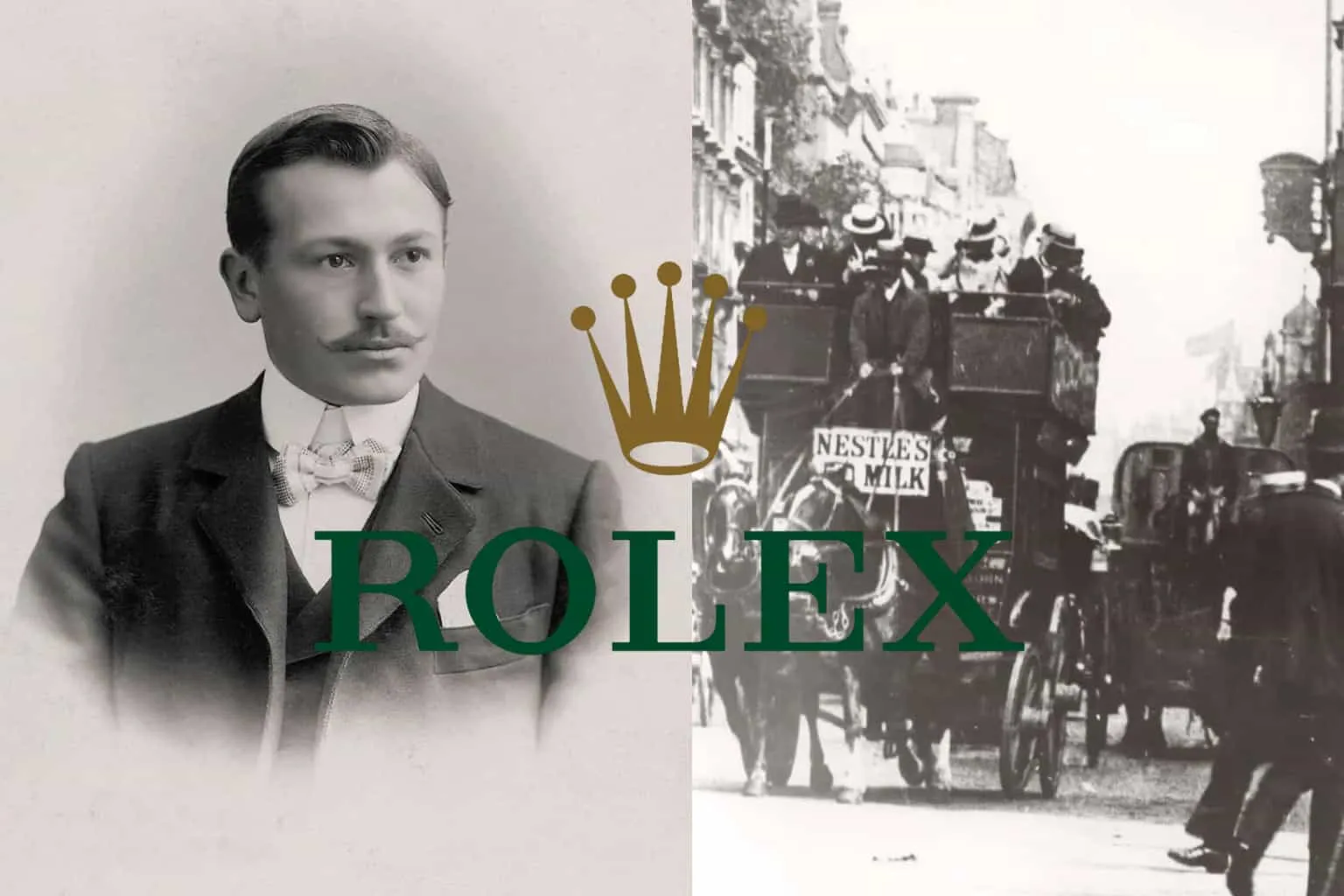
Hans, at the age of 19, came to Switzerland, which was famous for its clockmaking, and took up a position as a translator at one of the largest watch exporting companies in the country. During this time, he keenly observed the high profits in the watch industry. Leveraging his sharp business acumen, he quickly established his own office in Switzerland, focusing on the export of Swiss watches.
In 1903, Hans moved to London, and two years later, he partnered with his friend Alfred Davis to co-found Wilsdorf & Davis Ltd. They introduced high-quality Swiss-made watch components and outsourced the movements, eventually selling the finished products under the WD company brand to retailers, generating profits.
Although pocket watches were still the dominant market trend at the time, Hans foresaw the immense potential of wristwatches, firmly believing that portable timepieces represented the future development. This foresight laid the foundation for his later success.

In 1908, Hans registered his own wristwatch brand, "Rolex," and began selling watches under the Rolex trademark. The brand's logo evolved from a hand with five outstretched fingers to a crown, symbolizing Rolex's status as the king of the watchmaking industry.
To further prove the strength of the brand, Hans sought the endorsement of authoritative institutions.
In 1910, the Rolex wristwatch became the first to be awarded the Swiss Certificate of Chronometric Precision by the Official Watch Rating Center in Bienne, Switzerland.
This certification from a reputable institution helped to establish Rolex as a brand known for its precision and technical excellence in the watchmaking industry.
By obtaining this prestigious certification, Hans was able to showcase Rolex's capabilities and build trust with consumers, further solidifying the brand's reputation and position in the market.
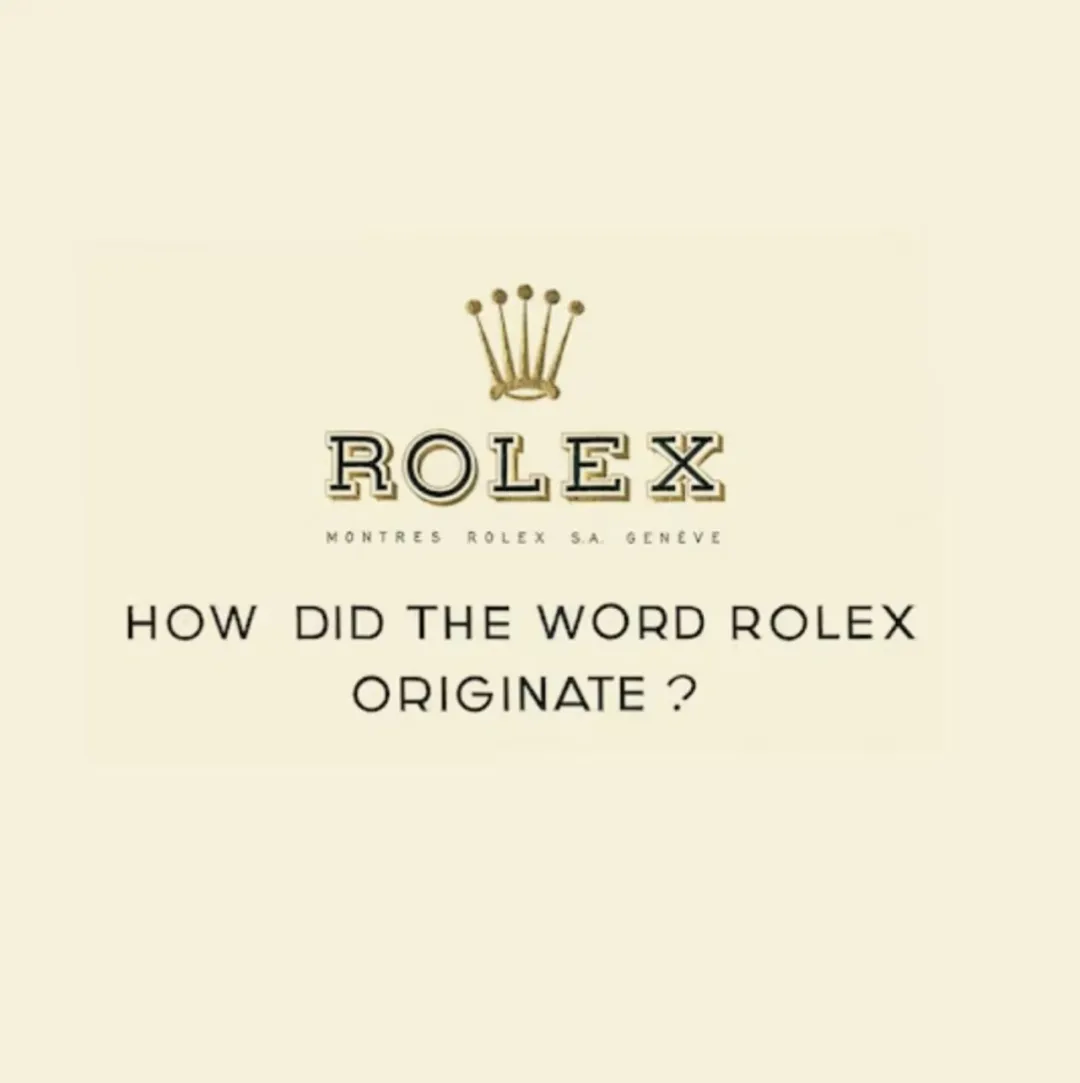
In 1914, Rolex watches also received the prestigious "A" rating certificate from the Kew Observatory in the United Kingdom, further cementing their reputation for exceptional timekeeping accuracy.
The Kew Observatory "A" certification was a highly coveted achievement in the watchmaking industry at the time. It demonstrated that Rolex watches not only met the stringent standards set by the Swiss rating center, but also excelled in precision timekeeping when evaluated by the renowned British observatory.
This dual certification from respected institutions in both Switzerland and the UK served to enhance Rolex's credibility and solidify its status as a manufacturer of high-precision, top-quality timepieces. The accumulation of these accolades helped to establish Rolex as a brand synonymous with reliability, accuracy, and technical excellence in the early 20th century.
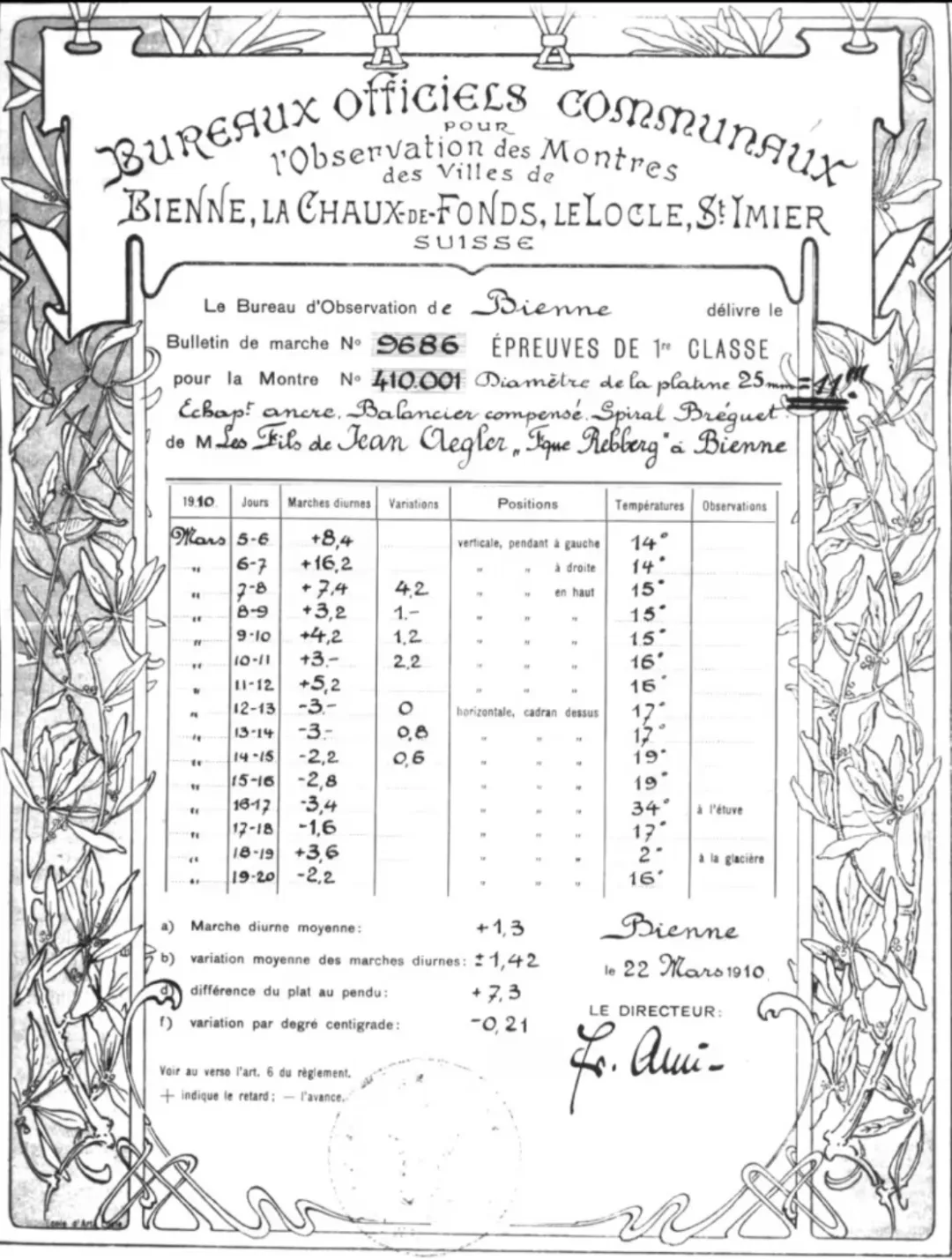
The Rolex Saga: From a Small London Office to a Worldwide Luxury Powerhouse
In 1914, the outbreak of World War I led the British government to significantly raise tariffs on non-essential goods, including wristwatches. This had a substantial impact on Rolex.
As a result, in 1915, Hans relocated the company to Switzerland, allowing Rolex watches to be directly produced, assembled, and tested in Switzerland before being exported, thus avoiding the high tariffs. After the move to Switzerland, Rolex gradually established itself as a Swiss luxury watch brand.
By shifting its base of operations to Switzerland, Rolex was able to navigate the challenging wartime trade environment and continue its growth trajectory. This strategic relocation proved pivotal in the brand's evolution, enabling it to maintain its competitive edge and solidify its reputation as a Swiss-made watch of exceptional quality.
The move to Switzerland marked a crucial turning point, laying the foundation for Rolex to become the globally recognized Swiss luxury watch brand that it is today.

During World War I, the inconvenience of using pocket watches led soldiers to creatively adapt them into wristwatches, significantly facilitating the checking of time on the battlefield. This helped to popularize the use of wristwatches.
After the war, wristwatches began to gain greater acceptance among men. In this context, Rolex had already obtained certification from the Swiss Observatory, solving the issue of timekeeping accuracy.
With the precision problem addressed, Hans Wilsdorf then focused on researching waterproof and dustproof features for Rolex watches.
In 1926, Rolex introduced the world's first waterproof and dustproof wristwatch - the Oyster.
This pioneering Oyster model, with its innovative case design, marked a significant milestone in Rolex's history and contributed to the growing popularity of wristwatches among the general public in the post-war era.
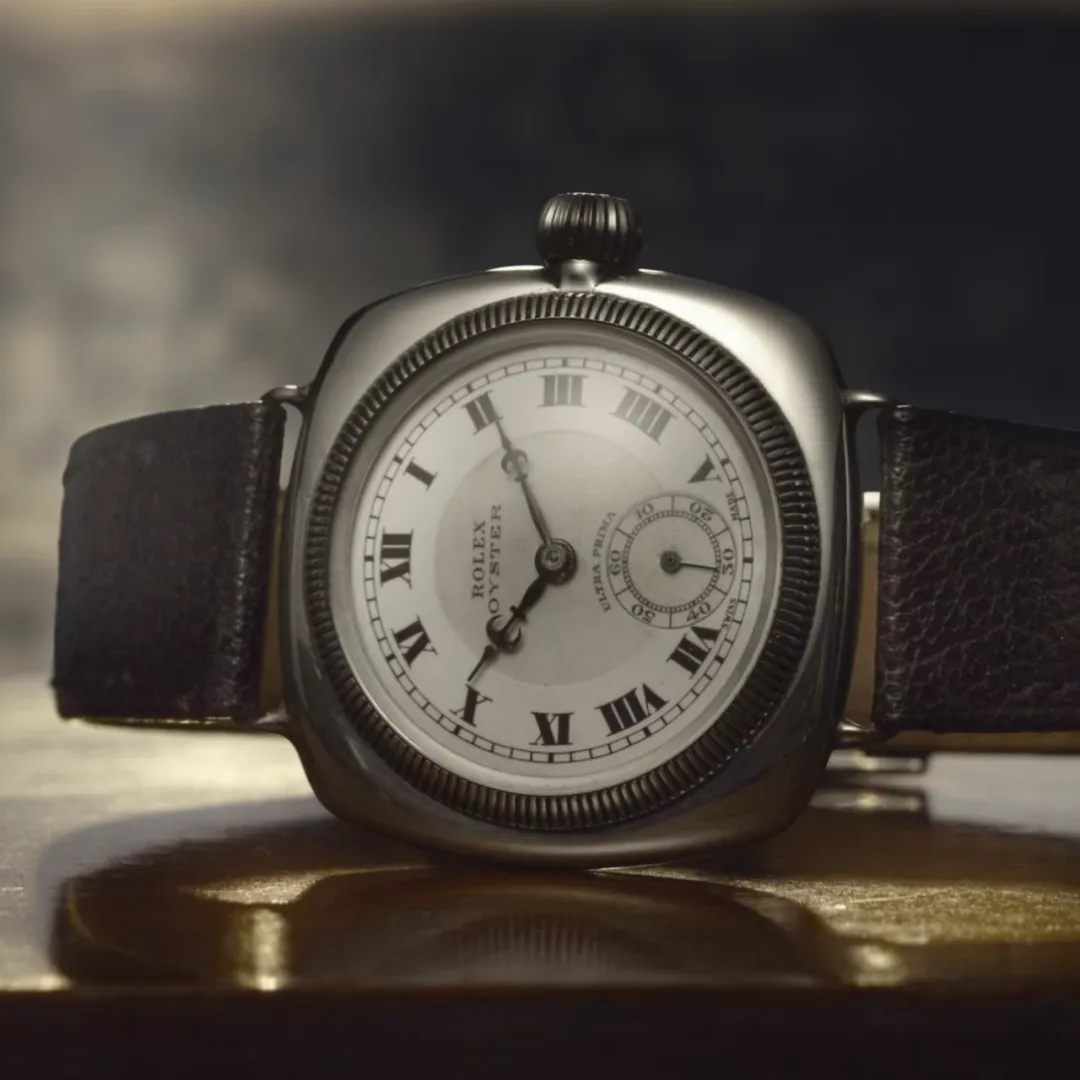
That's an interesting anecdote about the inspiration behind the Rolex Oyster watch design. According to the story, it was Hans Wilsdorf's experience eating oysters that sparked the idea for the Oyster case.
Apparently, Wilsdorf found that while the oyster shells were hard and tightly sealed, the meat inside was delicate and soft. This observation seemingly led him to conceptualize a wristwatch case that could be equally robust on the outside, yet protect the delicate internal mechanisms just as an oyster shell safeguards its precious pearl.
The parallels between the natural design of an oyster shell and the engineering requirements for a waterproof watch case must have resonated with Wilsdorf. This serendipitous moment of inspiration, drawn from the everyday experience of enjoying a simple oyster, ultimately resulted in the pioneering Oyster case that would become an iconic Rolex design.

In 1931, Rolex took watchmaking innovation even further by inventing the self-winding mechanism, which revolutionized the industry.
With this groundbreaking development, Rolex created a watch that could automatically wind itself through the natural motion of the wearer's arm. All it took was a slight movement of the wrist to keep the watch perpetually wound and powered.
This self-winding or "automatic" mechanism was a game-changing advancement that eliminated the need for manual winding. It provided wearers with the convenience of a watch that required minimal user intervention to maintain its timekeeping accuracy.
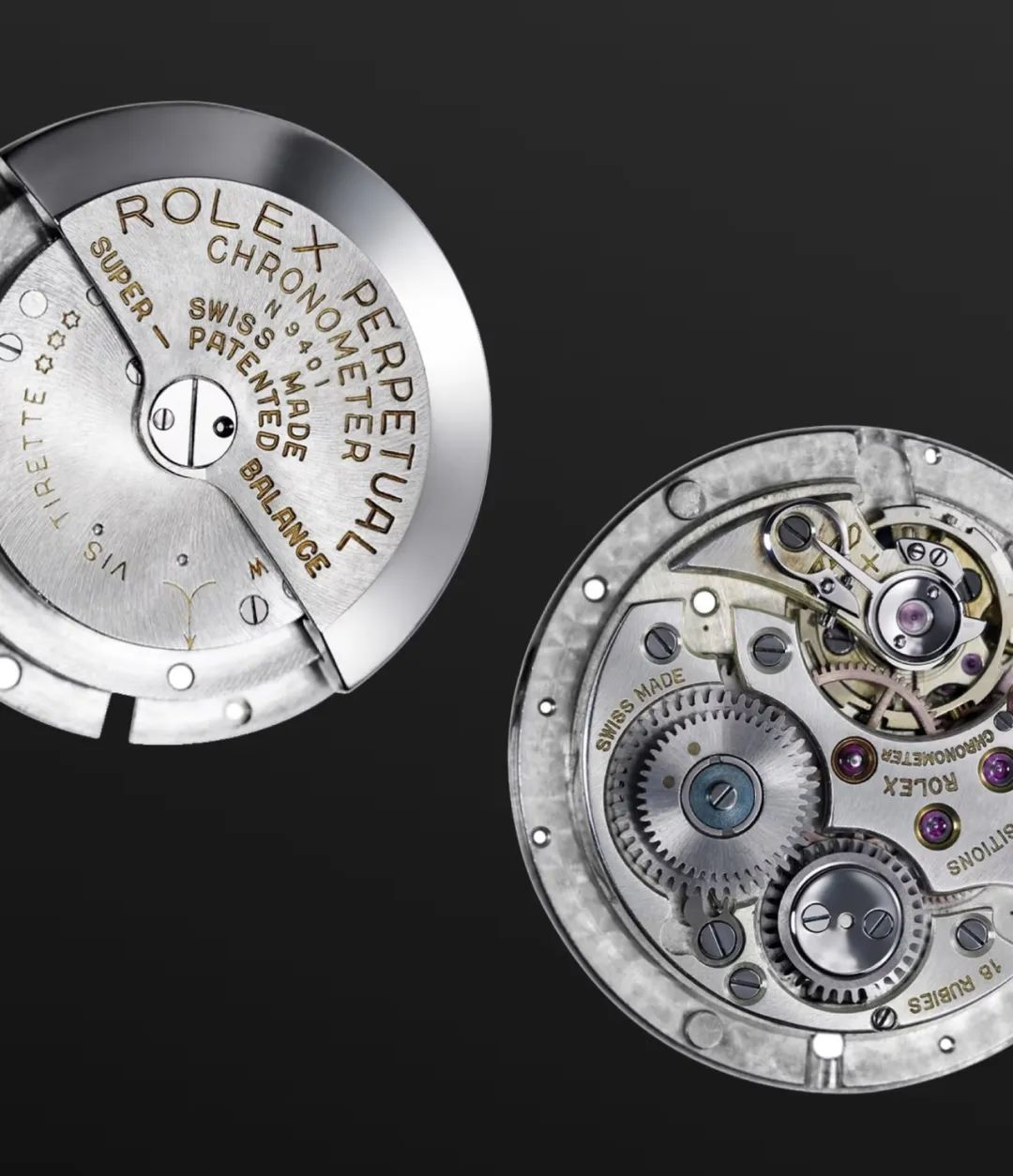
Watchmaking Royalty: Rolex's Unparalleled Marketing Prowess
After addressing the issues of timekeeping precision and durability, Hans Wilsdorf employed some ingenious marketing tactics to further elevate the Rolex brand.
Firstly, he showcased the capabilities of Rolex watches, such as demonstrating the waterproof performance of the Oyster case by submerging it in an aquarium in the company's retail stores. This hands-on approach allowed potential customers to witness the watches' exceptional water resistance in person.
Secondly, Rolex strategically aligned itself with extreme sports and high-performance activities, cementing its reputation as a watch brand synonymous with innovation and reliability. This association with adventurous endeavors and record-setting feats helped to position Rolex as a timepiece for the elite and the daring.
A prime example of this marketing strategy was Rolex's sponsorship of British swimmer Mercedes Gleitze in 1927. Gleitze wore a Rolex Oyster watch during her successful attempt to swim across the English Channel, and the watch continued to function flawlessly even after 15 hours in the water. This impressive demonstration of the Oyster's waterproof capabilities earned Rolex invaluable publicity and cemented its status as a truly pioneering and dependable brand.
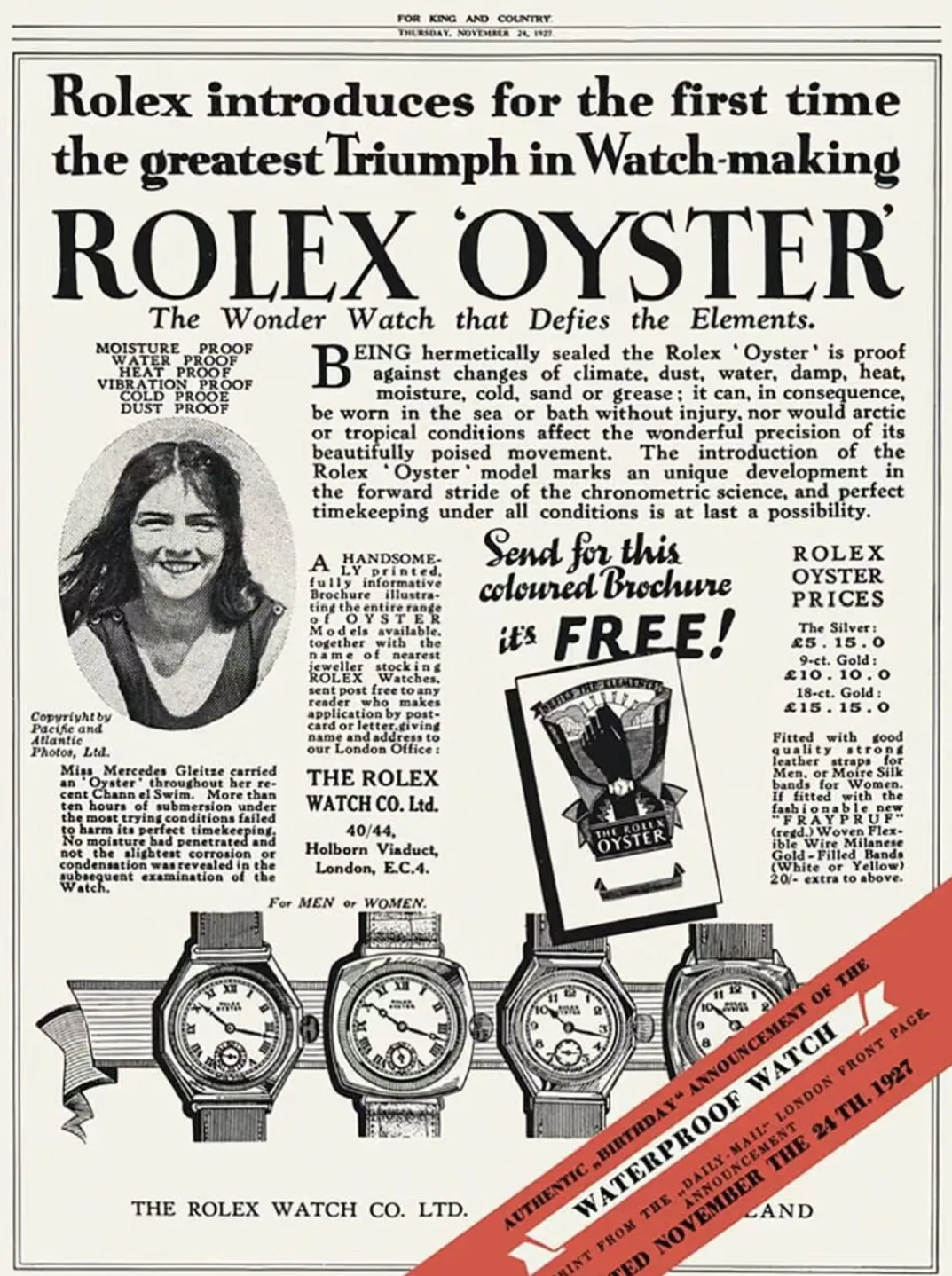
Rolex continued to leverage its association with extreme feats and notable historical figures to further enhance its brand image and reputation.
In 1933, Lord Clydesdale wore a Rolex watch during his flight over Mount Everest. This daring expedition in a perilous environment once again demonstrated the reliability and resilience of Rolex watches, cementing the brand's status as a trusted companion for the most challenging endeavors.
Furthermore, Rolex strategically presented commemorative watches to revered historical figures as a means of elevating its brand prestige. This gesture of gifting special edition timepieces to influential leaders and pioneers served to align Rolex with success, power, and legacy.
Notably, in 1945, Rolex presented its 100,000th and 150,000th watches to former British Prime Minister Winston Churchill and former U.S. President Dwight D. Eisenhower, respectively. These high-profile associations with such esteemed individuals further reinforced Rolex's position as a brand favored by the elite and the accomplished.

Since then, American presidents such as Johnson, Reagan, Obama, Trump, and Biden have also worn Rolex watches, so Rolex watches are called "presidential watches."
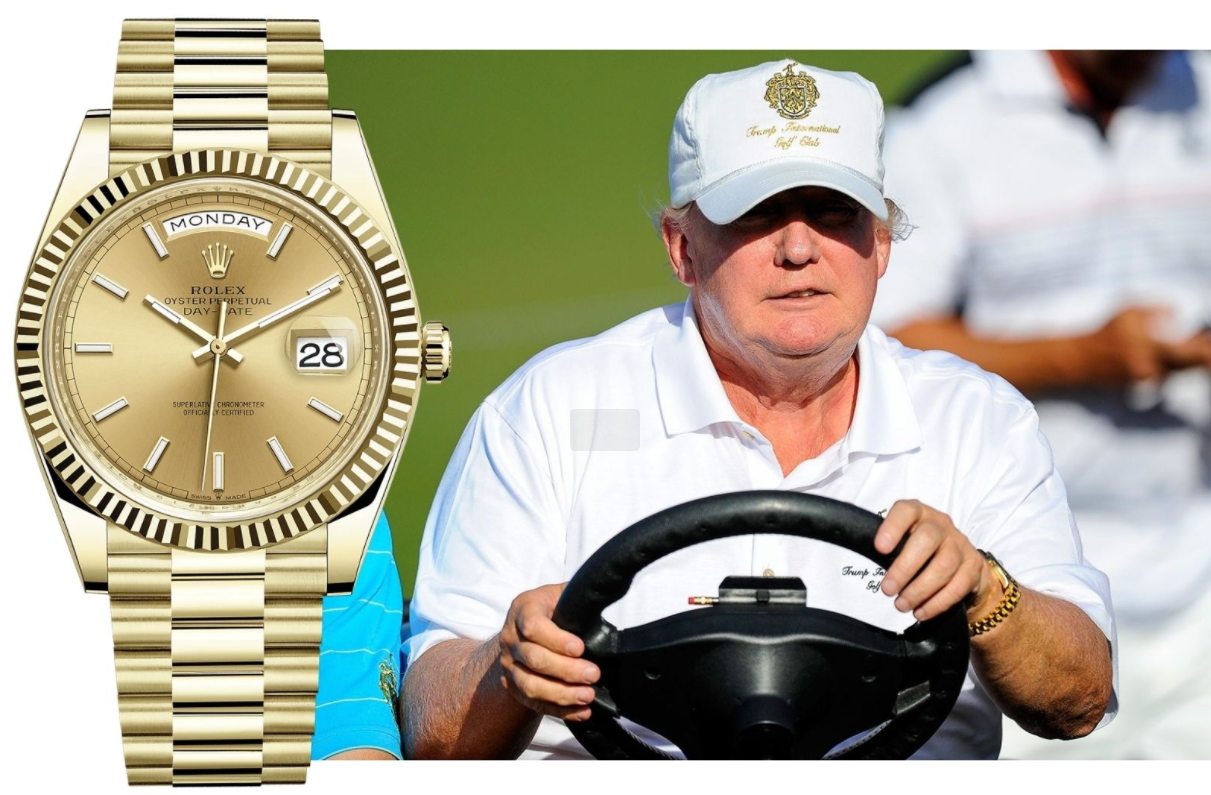

Timeless Craftsmanship, Eternal Purpose: Rolex's Uncompromising Vision
Rolex's unwavering commitment to high-quality, handcrafted mechanical watches has been a key factor in its success as a luxury brand.
When the Japanese introduced the world's first commercially viable quartz watch in 1969, it posed a significant challenge to the traditional Swiss mechanical watch industry. Quartz watches offered a much lower cost and higher accuracy compared to their mechanical counterparts, leading to a rapid rise in popularity and market share.
However, Rolex resolutely maintained its focus on mechanical watch movements, refusing to compromise on the brand's core values and craftsmanship. While other Swiss brands struggled to adapt to the quartz revolution, Rolex steadfastly upheld its dedication to the art of mechanical watchmaking.
This steadfast commitment to mechanical precision and traditional watchmaking techniques allowed Rolex to differentiate itself from the mass-produced, battery-powered quartz watches. By continuing to offer a superior, handcrafted product, Rolex was able to solidify its position as a premier luxury brand, appealing to discerning consumers who valued the heritage, exclusivity, and artistry inherent in a Rolex timepiece.

Rolex's steadfast decision to not produce quartz watches, and instead remain committed to the handcrafted production of high-quality mechanical timepieces, has been a key factor in preserving the brand's value and exclusivity.
While many other Swiss watch brands succumbed to the quartz crisis and outsourced production to keep up with the demand for cheaper, mass-produced quartz watches, Rolex took a different approach. The company remained resolute in its dedication to mechanical watchmaking, refusing to compromise on its core principles and craftsmanship.
Rolex's insistence on in-house production, with each watch taking nearly a year to manufacture, has been crucial to maintaining the brand's prestige and value. By not outsourcing or adapting to the quartz revolution, Rolex was able to weather the storm and emerge as one of the few surviving Swiss mechanical watch manufacturers.
This unwavering commitment to traditional watchmaking techniques, even in the face of disruptive market changes, has allowed Rolex to cultivate an image of exclusivity, precision, and timeless elegance. As the quartz watch craze eventually subsided, Rolex's steadfast adherence to its core values positioned the brand as a symbol of enduring quality and craftsmanship, highly sought after by discerning consumers.
Scaling the Heights of Luxury: An Analysis of Rolex's Peerless Brand Value
Rolex's design is classic and well-behaved. There are no major changes every year. The watch models are not outdated and meet the needs of most users.
Such a design meets the low-key identity needs of the rich, slows down the depreciation of Rolex, and enhances consumers' purchasing confidence.
Rolex also regularly increases prices to ensure that the brand has room for appreciation, and maintains market popularity and inventory balance by bundling popular and unpopular models.

Rolex's success lies not only in its exquisite craftsmanship and innovative marketing strategies, but also in its persistence and maintenance of brand value.
Through genius marketing methods, insisting on hand-made high-quality mechanical watches, not making major changes and regularly raising prices, Rolex has gradually become a household luxury brand from a timing tool originally built for extreme sports such as diving and mountaineering.
Over time, Rolex has not only become synonymous with luxury, but also symbolizes precision, durability and noble brand image.
It is this brand strategy of not following the trend, staying sober, and constantly focusing on sustainable development that enables Rolex to create a truly timeless brand.
Whether facing fierce market competition or changes in consumer trends, Rolex will continue to lead the trend of the watch industry with its excellent quality and unique brand value.
Navigating Tomorrow's Challenges: Assessing Rolex's Path Forward
Entering 2024, Rolex still maintains its leading position in the industry. According to the latest financial report data, Rolex's total sales in 2023 reached 14.8 billion Swiss francs, an increase of 7.3% over the previous year. The profit margin also remained at a high level of nearly 40%, fully demonstrating the brand's strong pricing power and brand influence in the luxury watch market.
However, since the outbreak of the epidemic in 2020, the luxury industry as a whole has been hit hard. Even top brands like Rolex have not been able to completely avoid the pressure of price cuts. According to the latest data, the average retail price of some popular Rolex models in 2023 has dropped by 5-10% compared with before the epidemic. This change reflects the overall slowdown in consumer demand for luxury goods in the post-epidemic era.
In general, the price reduction pressure faced by Rolex reflects that the entire luxury industry is undergoing a period of transformation. Rolex needs to better adapt to changes in consumer demand in the post-epidemic era while maintaining its brand uniqueness, and ensure that it continues to maintain its leading position in the high-end watch market through measures such as product innovation, pricing strategy adjustment and brand image upgrade.
Under the premise of continuous innovation and adaptation to change, Rolex is expected to continue to maintain its industry leadership in the field of high-end watches and provide consumers with better product and service experience. Finally, as E.W watches Rolex sellers, we certainly hope that the Rolex brand will get better and better, and more and more people will join the Rolex watch camp. Finally, of course, if you are interested, Welcome to check out our popular and affordable entry-level styles below.
E.W watches Rolex Rolex full range

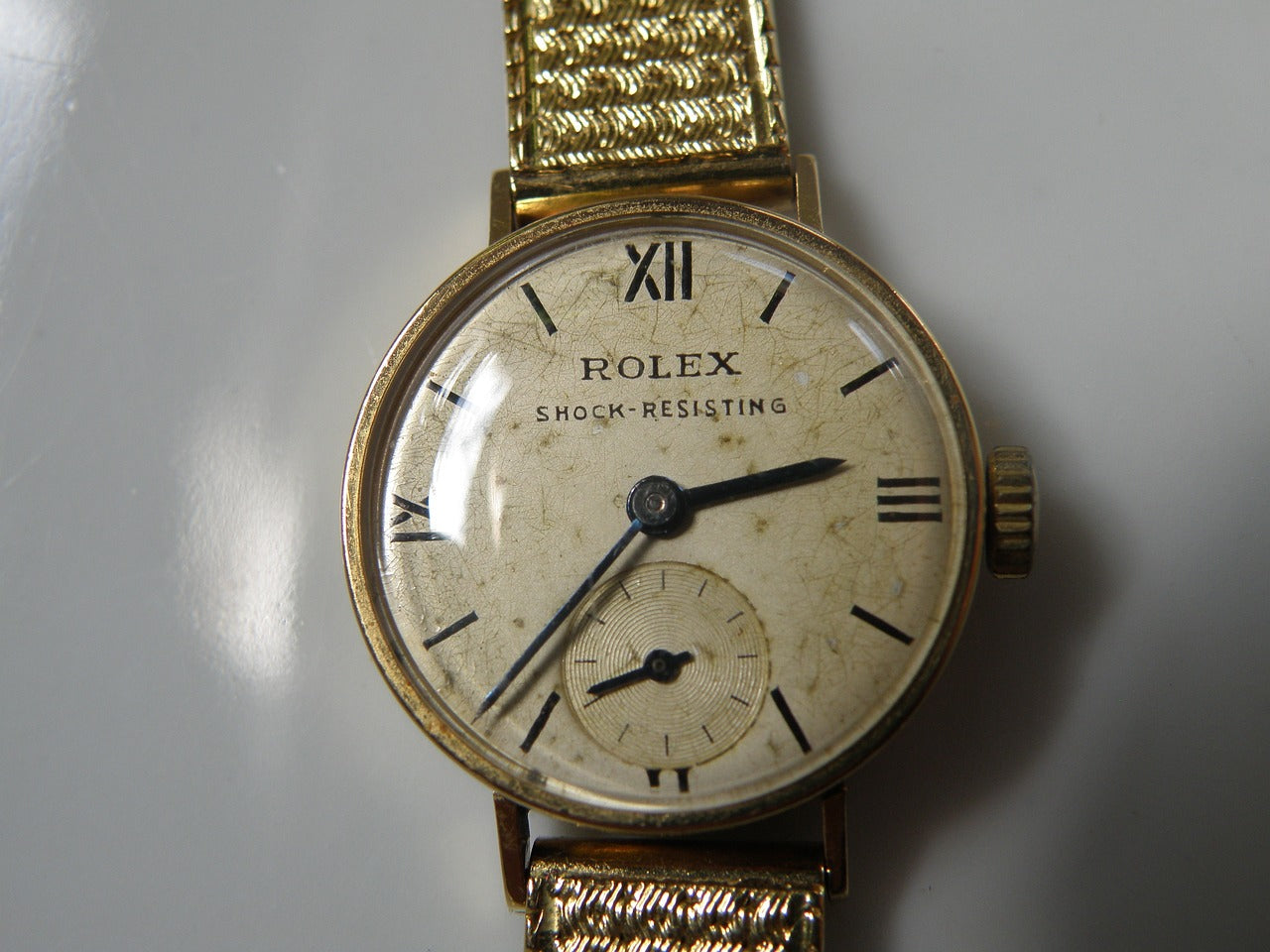

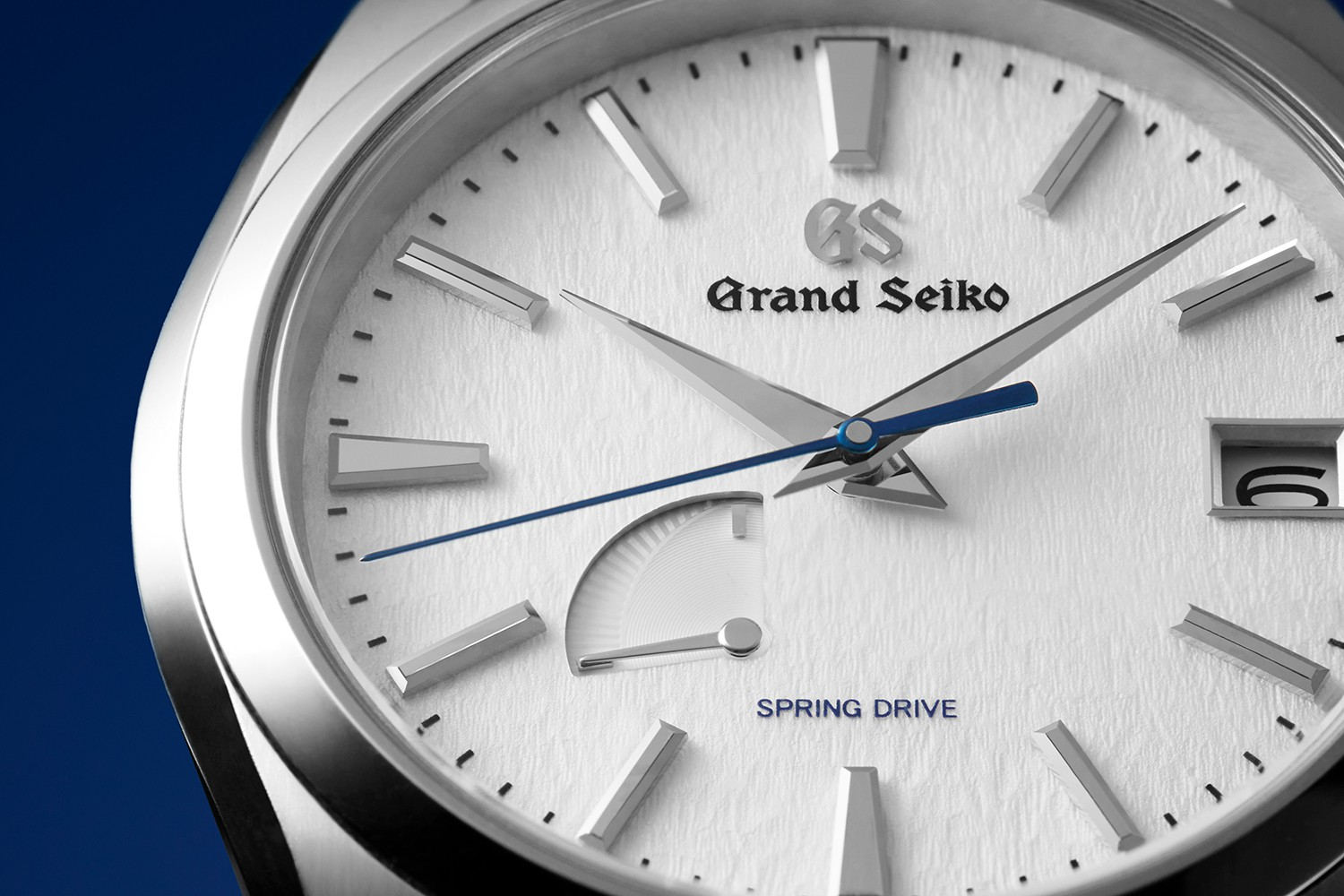

Share:
The Five Biggest Enemies of Mechanical Watches Every Watch Owner Should Know
How to identify the real and fake Daytona, real case